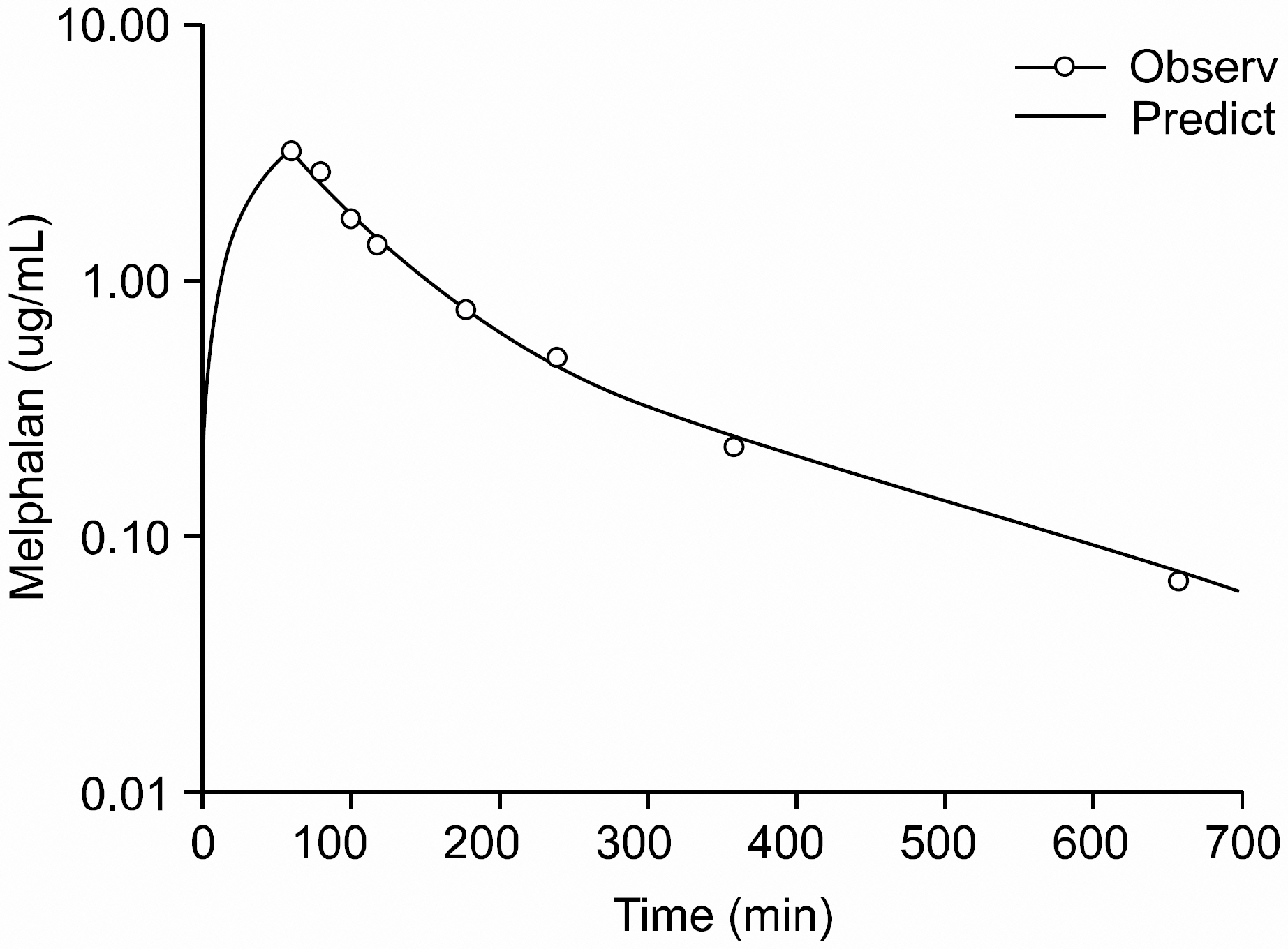Korean J Hematol.
2007 Jun;42(2):122-128. 10.5045/kjh.2007.42.2.122.
Pharmacokinetics of High-dose Intravenous Melphalan in Patients Undergoing Autologous Stem Cell Transplantation
- Affiliations
-
- 1Health Promotion Center, St. Mary's Hospital, The Catholic University of Korea College of Medicine, Korea.
- 2Department of Internal Medicine, St. Vincent's Hospital, The Catholic University of Korea College of Medicine, Suwon, Korea. kimhoonkyo@yahoo.co.kr
- 3Department of Biomedicine, The Catholic University of Korea College of Medicine, Seoul, Korea.
- KMID: 2083509
- DOI: http://doi.org/10.5045/kjh.2007.42.2.122
Abstract
-
BACKGROUND: Melphalan is frequently used in conditioning regimens prior to autologous stem cell transplantation. The pharmacokinetics of melphalan have shown great interindividual variations. This study aims to investigate the pharmacokinetics of melphalan and to study those influences on renal function and the clinical outcomes.
METHODS
The pharmacokinetics of melphalan following high dose (100~140mg/m(2)) i.v. administration was determined in 11 patients suffering with advanced malignancies and who were undergoing autologous stem cell transplantation. The plasma level of melphalan was assayed by a specific HPLC method.
RESULTS
The pharmacokinetics parameters (median AUC: 625.2mg/L/min, steady-state volume of distribution (Vdss): 14.87L/m(2), total body clearance: 0.2L/min/m(2), half life: 55.9 min, and maximal plasma concentration: 7.61mg/L) were similar to those reported in the literature. No relationship between the pharmacokinetics of melphalan and creatinine clearance, the non-hematologic toxicities and relapse was observed. Only Vdss was correlated with myelosuppression (P<0.05).
CONCLUSION
The pharmacokinetics of melphalan were similar to those reported in Caucasians. The PK parameters did not correlate with the clinical outcomes in patients with normal renal function. Further studies on patients with renal failure are needed.
Keyword
MeSH Terms
Figure
Reference
-
1). Sarosy G., Leyland-Jones B., Soochan P., Cheson BD. The systemic administration of intravenous melphalan. J Clin Oncol. 1998. 6:1768–82.
Article2). Samuels BL., Bitran JD. High-dose intravenous melphalan: a review. J Clin Oncol. 1995. 13:1786–99.
Article3). Pinguet F., Joulia JM., Martel P., Grosse PY., Astre C., Bressolle F. High-performance liquid chromatographic assay for melphalan in human plasma. Application to pharmacokinetic studies. J Chromatogr B Biomed Appl. 1996. 686:43–9.
Article4). Pinguet F., Martel P., Fabbro M, et al. Pharmacokinetics of high-dose intravenous melphalan in patients undergoing peripheral blood hematopoietic progenitor-cell transplantation. Anticancer Res. 1997. 17:605–11.5). Tricot G., Alberts DS., Johnson C, et al. Safety of au-totransplants with high-dose melphalan in renal failure: a pharmacokinetic and toxicity study. Clin Cancer Res. 1996. 2:947–52.6). Kergueris MF., Milpied N., Moreau P., Parousseau JL., Larousse C. Pharmacokinetics of high-dose melphalan in adults: influence of renal function. Anticancer Res. 1994. 14:2379–82.7). Cornwell GG 3rd., Pajak TF., Mclntyre OR., Kochwa S., Dosik H. Influence of renal failure on myelosup-pressive effects of melphalan: Cancer and Leukemia Group B experience. Cancer Treat Rep. 1982. 66:475–81.8). Ballester OF., Tummala R., Janssen WE, et al. High-dose chemotherapy and autologous peripheral blood stem cell transplantation in patients with multiple myeloma and renal insufficiency. Bone Marrow Transplant. 1997. 20:653–6.
Article9). Tosi P., Zamagni E., Ronconi S, et al. Safety of autologous hematopoietic stem cell transplantation in patients with multiple myeloma and chronic renal failure. Leukemia. 2000. 14:1310–3.
Article10). Sirohi B., Powles R., Kulkarni S, et al. Glomerular filtration rate prior to high-dose melphalan 200mg/m(2) as a surrogate marker of outcome in patients with myeloma. Br J Cancer. 2001. 85:325–32.11). McCune JS., Gibbs JP., Slattery JT. Plasma concentration monitoring of busulfan: does it improve clinical outcome? Clin Pharmacokinet. 2000. 39:155–65.12). Hassan M. The role of busulfan in bone marrow transplantation. Med Oncol. 1999. 16:166–76.
Article13). Slattery JT., Risler LJ. Therapeutic monitoring of busulfan in hematopoietic stem cell transplantation. Ther Drug Monit. 1998. 20:543–9.
Article
- Full Text Links
- Actions
-
Cited
- CITED
-
- Close
- Share
- Similar articles
-
- Advanced POEMS syndrome treated with high-dose melphalan followed by autologous blood stem cell transplantation: a single-center experience
- Complete Remission in a Patient with Multiple Myeloma after High Dose Melphalan and CD34+ Selected Autologous Transplantation
- Busulfan plus melphalan versus high-dose melphalan as conditioning regimens in autologous stem cell transplantation for newly diagnosed multiple myeloma
- Pre-transplant Disease Status is Important for an Improved Outcome of the Second Stem Cell Transplantation in the Myeloma Patients Receiving the First Autologous Stem Cell Transplantation
- Bortezomib and melphalan as a conditioning regimen for autologous stem cell transplantation in multiple myeloma


